11534 AN EARLY NINETEENTH CENTURY WATERCOLOR OF THE ORIGIN OF THE CORINTHIAN COLUMN, AFTER GIACONDO ALBERTOLLI Italian. Signed and Dated Giacomo Zalli, 1832. Measurements: Framed: Height: 20 1/2″ (52 cm); Width: 25 1/2″ (64.5 cm).

Research
Watercolor on paper.
Marks:
Inscribed on lower left ZALLI GIACOMO Fece 1832
This watercolor is executed after an original engraving by Giacondo Albertolli (1743–1839), a Swiss-born architect, painter and sculptor who was active as a student and stuccoist in Italy from the 1760s onward. He was most known for his designs for architectural ornament and was elected professor of ornamenti architettonici at the Brera Academy in Milan in 1776. He was employed in the decoration of churches, palaces and public buildings in Italy, and in 1809 was made Knight of the Iron Crown by Napoleon I.
Throughout his life, Albertolli published a number of treatises on art, including Corso elementare di ornamenti architettonici in 1805, in which the present design was included as plate XXV (figure 1). The caption for this “Origin of the Corinthian Column” reads: “Callimaco, a Greek sculptor, having seen at random a basket, around which an Acanthus plant had negligently raised its foliage, and its stems, conceived the idea of the Corinthian capital.”
This history, as annotated by Albertiolli, is relayed by the Roman writer Vitruvius (c. 75 BC–c. 15 BC). He writes that upon the death of a girl from Corinth, a basket of trinkets that had delighted her when living was taken by her nurse and left at her grave, covered with a tile to protect the items from the elements. The basket happened to be placed on the roots of an acanthus and, when springtime came, the leaves and shoots grew up the sides of the baskets, some of which were forced downward into curled volutes under the weight of the tile. The Greek architect and sculptor, Callimachus, came upon this monument and, “pleased with the style and novelty of the grouping, he made columns for the Corinthians on this model and fixed the proportions.” Examples of this scene were illustrated by Roland Fréart, sieur de Chambray in Parallèle de l’architecture antique avec la modern of 1650 (figure 2) and in Claude Perault’s translation of Vitruvius’ Ten Books on Architecture in 1684 (figure 3).
The present watercolor is signed at the lower left ZALLI GIACOMO Fece 1832. No information on this artist has come to light as yet, but it may be assumed that he was a student of architecture, using Albertolli’s guide as an instructional resource to produce not only an informed study but a charming work of art.
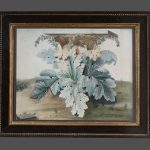

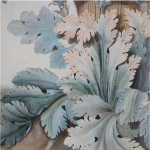
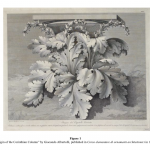
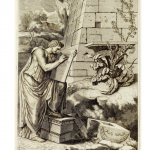
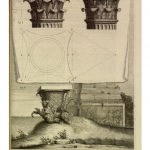
Comments are closed.